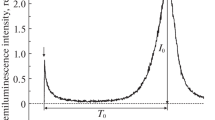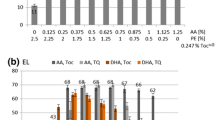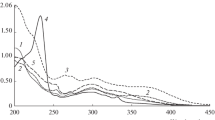Abstract
The physicochemical interactions between alpha-tocopherol and three phenolic acids, which constitute main phenolics in coffee brew: caffeic, chlorogenic and ferulic acid, in l-α-phosphatidylcholine liposome system were studied. Steady-state and fluorescence lifetime measurements were applied to elucidate location of investigated phenolic acids in liposomes, and the results have shown that ferulic acid is most embedded into membrane structure. Lipophilic studies have shown that at pH 7.4 the partition coefficients for all phenolic acids are similar. Antioxidant capacity measurements of studied antioxidants were taken using fluorescent probe BODIPY. The synergistic effect was observed in all tested antioxidant systems with the exception of sample consisting of chlorogenic acid (2.5 μM) and alpha-tocopherol (2.5 μM), where antagonistic effect was noted. Concentration of antioxidants was a significant factor in the observed phenomenon. The most effective antioxidant system against oxidation in liposomes was combination of alpha-tocopherol and ferulic acid. This phenomenon could be explained by interaction of ferulic acid with the interior of the phospholipids membrane.





Similar content being viewed by others
Abbreviations
- AAPH:
-
2,2′-Azobis(2-amidinopropane) dihydrochloride
- α-T:
-
Alpha-tocopherol
- C11-BODIPY581/591:
-
4,4-Difluoro-5-(4-phenyl-1,3-butadienyl)-4-bora-3a,4a-diaza-s-indacene-3-undecanoic acid
- CA:
-
Caffeic acid
- CGA:
-
Chlorogenic acid
- C OB :
-
Partition coefficient
- DPH:
-
1,6-Diphenyl-1,3,5-hexatriene
- FA:
-
Ferulic acid
- PCF:
-
Protection coefficient
- PC:
-
l-α-Phosphatidylcholine
References
Laguerre M, Lecomte J, Villeneuve P (2007) Review evaluation of the ability of antioxidants to counteract lipid oxidation: existing methods, new trends and challenges. Prog Lipid Res 46:244–282
Nogala-Kałucka M, Dwiecki K, Siger A, Górnaś P, Polewski K, Ciosek S (2013) Antioxidant synergism and antagonism between tocotrienols, quercetin and rutin in model system. Acta Alim 42:360–370
Altunkaya A, Becker EM, Gökmen V, Skibsted LH (2009) Antioxidant activity of lettuce extract (Lactuca sativa) and synergism with added phenolic antioxidants. Food Chem 115:163–168
Calvo P, Lozano M, Espinosa-Mansilla A, González-Gómeza D (2012) In-vitro evaluation of the availability of ϖ-3 and ϖ-6 fatty acids and tocopherols from microencapsulated walnut oil. Food Res Int 48:316–321
Marsanasco M, Márquez AL, Wagner JR, Alonso SV, Chiaramoni NS (2011) Liposomes as vehicles for vitamins E and C: an alternative to fortify orange juice and offer vitamin C protection after heat treatment. Food Res Int 44:3039–3046
Stone WL, Smith M (2004) Therapeutic uses of antioxidant liposomes. Mol Biotechnol 27:217–230
Schnitzer E, Pinchuk I, Lichtenberg D (2007) Peroxidation of liposomal lipids. Eur Biophys J 36:499–515
Shi J, Kakuda Y, Yeung D (2004) Antioxidative properties of lycopene and other carotenoids from tomatoes: synergistic effects. BioFactors 21:203–210
Gabrielska J, Soczyńska-Kordala M, Przestalski S (2004) Quercetin reduces prooxidant action of organometallic compounds on liposome membranes irradiated with UV. Pol J Environ Stud 13:509–514
Castelluccio C, Paganga G, Melikian N, Bolwell GP, Pridham J, Sampson J, Rice-Evans C (1995) Antioxidant potential of intermediates in phenylpropanoid metabolism in higher plants. FEBS Lett 368:188–192
Nardini M, Cirillo E, Natella F, Scaccini C (2002) Absorption of phenolic acids in humans after coffee consumption. J Agric Food Chem 50:5735–5741
Farah A, Monteiro M, Donangelo CM, Lafay S (2008) Chlorogenic acids from green coffee extract are highly bioavailable in humans. J Nutr 138:2309–2315
Górnaś P, Siger A, Polewski K, Pugajeva I, Waśkiewicz A (2014) Factors affecting tocopherol contents in coffee brews: NP-HPLC/FLD, RP-UPLC-ESI/MSn and spectroscopic study. Eur Food Res Technol 238:259–264
Górnaś P, Siger A, Pugajeva I, Czubinski J, Waśkiewicz A, Polewski K (2014) New insights regarding tocopherols in Arabica and Robusta species coffee beans: RP-UPLC-ESI/MSn and NP-HPLC/FLD study. J Food Compos Anal 36:117–123
Dwiecki K, Neunert G, Polewski P, Polewski K (2009) Antioxidant activity of daidzein, a natural antioxidant, and its spectroscopic properties in organic solvents and phosphatidylcholine liposomes. J Photochem Photobiol B 96:242–248
Hendrich AB, Malon R, Pola A, Shirataki Y, Motohashi N, Michalak K (2002) Differential interaction of Sophora isoflavonoids with lipid bilayers. Eur J Pharm Sci 16:201–208
Wang S, Meckling KA, Marcone MF, Kakuda Y, Tsao R (2011) Synergistic, additive, and antagonistic effects of food mixtures on total antioxidant capacities. J Agric Food Chem 59:960–968
Dwiecki K, Górnaś P, Wilk A, Nogala-Kałucka M, Polewski K (2007) Spectroscopic studies of D-α-tocopherol concentration-induced transformation in egg phosphatidylcholine vesicles. Cell Mol Biol Lett 12:51–69
Neunert G, Polewski P, Markiewicz M, Walejko P, Witkowski S, Polewski K (2010) Partition of tocopheryl glucopyranoside into liposome membranes studied by fluorescence methods. Biophys Chem 146:92–97
Samori B, Lenaz G, Battino M, Marconi G, Domini I (1992) On coenzyme Q orientation in membranes: a linear dichroism study of ubiquinones in a model bilayer. J Membr Biol 128:193–203
Heide UV, Ginkel G, Levine YK (1996) DPH is localized in two distinct populations in lipid vesicles. Chem Phys Lett 253:118–122
Konopasek I, Vecer J, Strzalka K, Amler E (2004) Short-lived fluorescence component of DPH reports on lipid–water interface of biological membranes. Chem Phys Lipids 130:135–144
Konopasek I, Kvasnicka P, Amler E, Kotyk A, Curatola G (1995) The transmembrane gradient of the dielectric constant influences the DPH lifetime distribution. FEBS Lett 374:338–340
Dwiecki K, Górnaś P, Jackowiak H, Nogala-Kałucka M, Polewski K (2007) The effect of D-alpha-tocopherol on the solubilization of dipalmitoylphosphatidylcholine membrane by anionic detergent sodium dodecyl sulfate. J Food Lipids 14:50–61
Sangster J (1997) Octanol-water partition coefficients: fundamentals and physical chemistry. Wiley, New York
Liao K, Yin M (2000) Individual and combined antioxidant effects of seven phenolic agents in human erythrocyte membrane ghosts and phosphatidylcholine liposome systems: importance of the partition coefficient. J Agric Food Chem 48:2266–2270
Garcia-Cones MT, Wilson PD, Plumb GW, Ralph J, Williamson G (1999) Antioxidant properties of 4,4′-dihydroxy-3,3′-dimethoxy-b,b′-bicinnamic acid (8-8-diferulic acid, non-cyclic form). J Sci Food Agric 79:379–384
Górnaś P, Neunert G, Baczyński K, Polewski K (2009) Beta-cyclodextrin complexes with chlorogenic and caffeic acids from coffee brew: spectroscopic, thermodynamic and molecular modelling study. Food Chem 114:190–196
Hait-Darshan R, Grossman S, Bergman M, Deutsch M, Zurgil N (2009) Synergistic activity between a spinach-derived natural antioxidant (NAO) and commercial antioxidants in a variety of oxidation systems. Food Res Int 42:246–253
Rice-Evans CA, Miller NJ, Paganga G (1996) Structure-antioxidant activity relationships of flavonoids and phenolic acids. Free Radic Biol Med 20:933–956
Noguchi N, Takahashi M, Tsuchiya J, Yamashita H, Komuro E, Niki E (1998) Action of 21-aminosteroid U74006F as an antioxidant against lipid peroxidation. Biochem Pharmacol 55:785–791
Liégeois C, Lermusieau G, Collin S (2000) Measuring antioxidant efficiency of wort, malt, and hops against the 2,2′-azobis(2-amidinopropane) dihydrochloride-induced oxidation of an aqueous dispersion of linoleic acid. J Agric Food Chem 48:1129–1134
Drummen GPC, van Liebergen LCM, Op den Kamp JAF, Post JA (2002) C11-BODIPY581/591, an oxidation-sensitive fluorescent lipid peroxidation probe: (micro)spectroscopic characterization and validation of methodology. Free Radic Biol Med 33:473–490
Heinonen M, Rein D, Satué-Gracia MT, Huang SW, German JB, Frankel EN (1998) Effect of protein on the antioxidant activity of phenolic compounds in a lecithin-liposome oxidation system. J Agric Food Chem 46:917–922
Corning PA (1998) The synergism hypothesis: on the concept of synergy and its role in the evolution of complex systems. J Soc Evol Syst 21:133–172
Chou TC (2006) Theoretical basis, experimental design, and computerized simulation of synergism and antagonism in drug combination studies. Pharmacol Rev 58:621–681
Becker EM, Nissen NL, Skibsted LH (2004) Antioxidant evaluation protocols: food quality and health effects. Eur Food Res Technol 219:561–571
Niki E (1987) Interaction of ascorbate and alpha-tocopherol. Ann N Y Acad Sci 498:186–199
Lin FH, Lin JY, Gupta RD, Tournas JA, Burch JA, Selim MA, Monteiro-Riviere NA, Grichnik JM, Zielinski J, Pinnell SR (2005) Ferulic acid stabilizes a solution of vitamins C and E and doubles its photoprotection of skin. J Invest Dermatol. 125:826–832
Graversen HB, Becker EM, Skibsted LH, Andersen ML (2008) Antioxidant synergism between fruit juice and alpha-tocopherol. A comparison between high phenolic black chokeberry (Aronia melanocarpa) and high ascorbic blackcurrant (Ribes nigrum). Eur Food Res Technol 226:737–743
Becker EM, Ntouma G, Skibsted LH (2007) Synergism and antagonism between quercetin and other chain-breaking antioxidants in lipid systems of increasing structural organization. Food Chem 103:1288–1296
Acknowledgments
This study was partially supported by a Grant 508/82-4 from Poznan University of Life Sciences, Poznan, Poland, and by a Grant N312 1410 33 from the Polish Ministry of Science and Higher Education.
Author information
Authors and Affiliations
Corresponding author
Ethics declarations
Conflict of interest
None.
Compliance with ethics requirements
This article does not contain any studies with human or animal subjects.
Rights and permissions
About this article
Cite this article
Neunert, G., Górnaś, P., Dwiecki, K. et al. Synergistic and antagonistic effects between alpha-tocopherol and phenolic acids in liposome system: spectroscopic study. Eur Food Res Technol 241, 749–757 (2015). https://doi.org/10.1007/s00217-015-2500-4
Received:
Revised:
Accepted:
Published:
Issue Date:
DOI: https://doi.org/10.1007/s00217-015-2500-4




